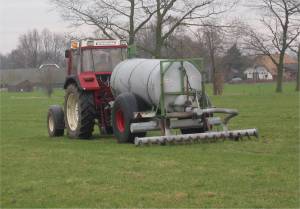Nitrate concentrations of our groundwater are among the highest in the European Union. The main reason is overfertilization of fields with feces from livestock farming. Every year, a “liquid manure shower” of 200 million tons goes down onto German fields, the result being too high nitrate levels at one third of the groundwater quality measurement points. Researchers of Karlsruhe Institute of Technology (KIT), together with the Foundation for the Environment of Rhineland-Palatinate and an environmental engineering office, are working on a very simple process for the large-scale cleaning of polluted drainage water from agricultural areas.
By early 2015 at the latest, German groundwater would have had to be in a “good state” according to EU directives, with nitrate concentrations lower than 50 mg per liter. According to the recent nitrate report issued by the Federal Government every four years, however, fertilizers used in agriculture still continue to adversely affect water quality in Germany, and there are hardly any signs of improvement. The situation is even worse in the few remaining moors that play an important role for the natural water budget and the binding of hazardous greenhouse gases: “Most of the bog is damaged,” Victoria Grießmeier of KIT’s Institute for Applied Biosciences (IAB) says.
To prevent polluted wastewater from agricultural areas from entering the groundwater or adjacent protection zones, the biologist is currently investigating a revolutionary filtration method. “The method was to be technically simple, not labor-intensive, and to work autonomously,” she describes the requirements. At the test facility located in the northwest of Rhineland-Palatinate, the Mürmes moor is shielded from surrounding fields by an underground basin. It contains microorganisms that convert the nitrate in the inflowing wastewater into atmospheric nitrogen (N2). “It is released as a gas and does not affect the climate,” Grießmeier says.
“The principle of denitrification is not new at sewage treatment plants,” Grießmeier continues. “But our facility in the open land runs completely autonomously without the addition of an artificial carbon source, such as methanol.” The latter is frequently used at municipal sewage treatment plants. Under conditions of reduced oxygen supply, bacteria only need natural “foodstuff,” such as wood chips, straw or green waste, which have to be refilled at large intervals. Other possible methods for nitrate removal, such as nanofiltration or electrodialysis, are not of biological nature. Field use of these methods is associated with a larger expenditure and higher costs, Grießmeier says.
At moderate inflows and nitrate concentrations of 100 to 150 mg/l, which corresponds to three times the limit value, the test facility of 180 m² in size succeeded in removing all the nitrate from the water. According to Grießmeier, further tests remain to be carried out to determine the extent to which such facilities would have to be built in order to solve the German nitrate problem and which side products are produced.
Background information: Nitratbericht 2016 – Gemeinsamer Bericht der Bundesministerien für Umwelt, Naturschutz, Bau und Reaktorsicherheit sowie für Ernährung und Landwirtschaft:
(in German only; Nitrate report 2016 – Joint report of the Federal Ministry for the Environment, Nature Conservation, Building, and Nuclear Safety and the Federal Ministry of Food and Agriculture)
In close partnership with society, KIT develops solutions for urgent challenges – from climate change, energy transition and sustainable use of natural resources to artificial intelligence, sovereignty and an aging population. As The University in the Helmholtz Association, KIT unites scientific excellence from insight to application-driven research under one roof – and is thus in a unique position to drive this transformation. As a University of Excellence, KIT offers its more than 10,000 employees and 22,800 students outstanding opportunities to shape a sustainable and resilient future. KIT – Science for Impact.

